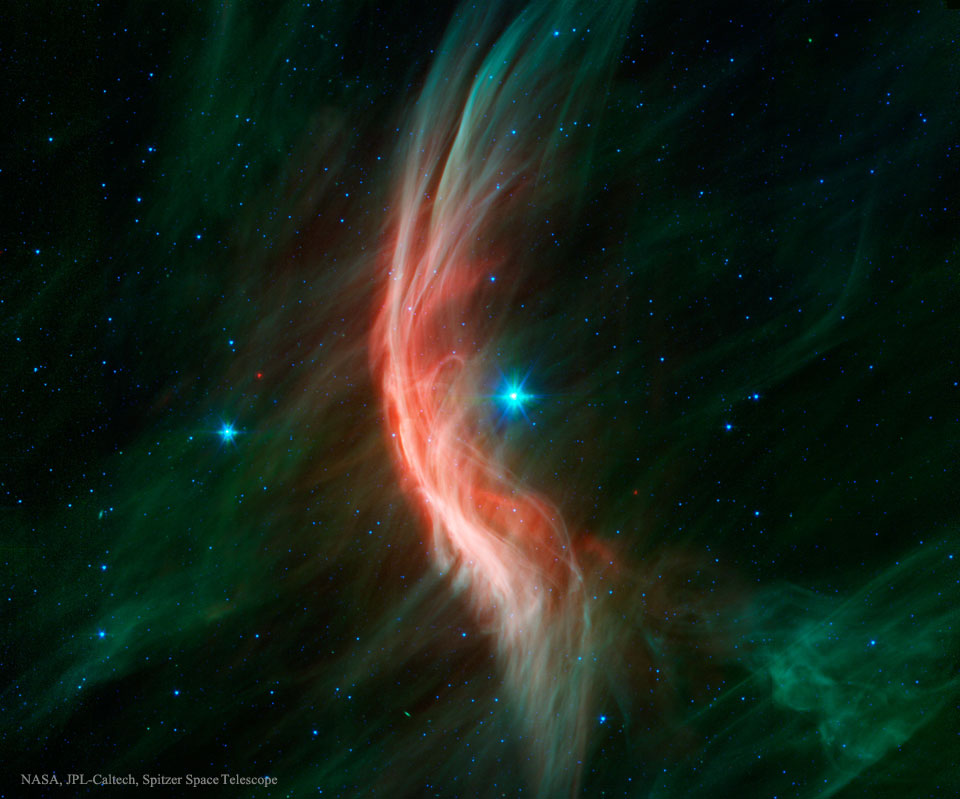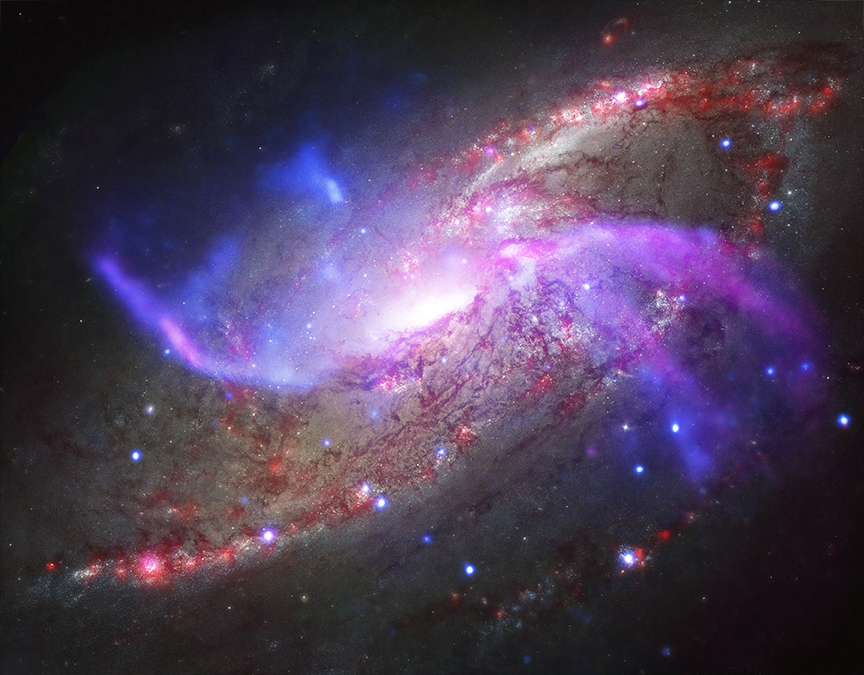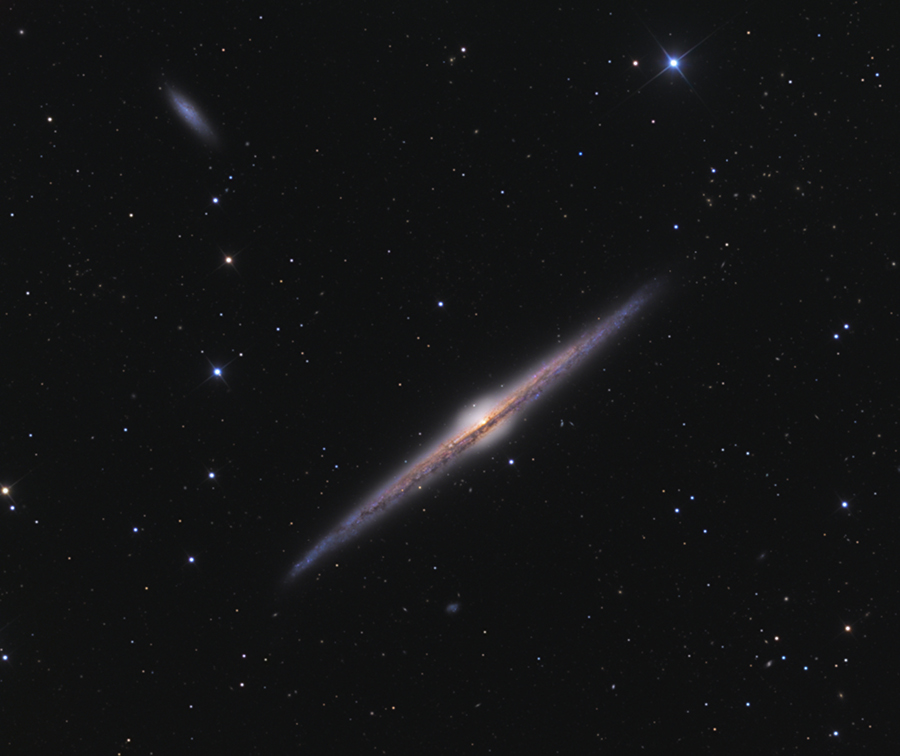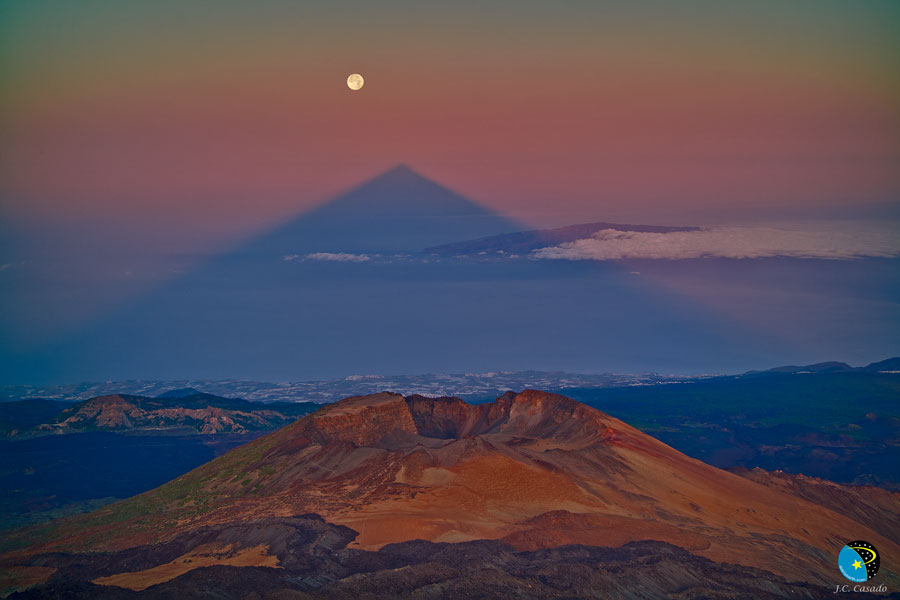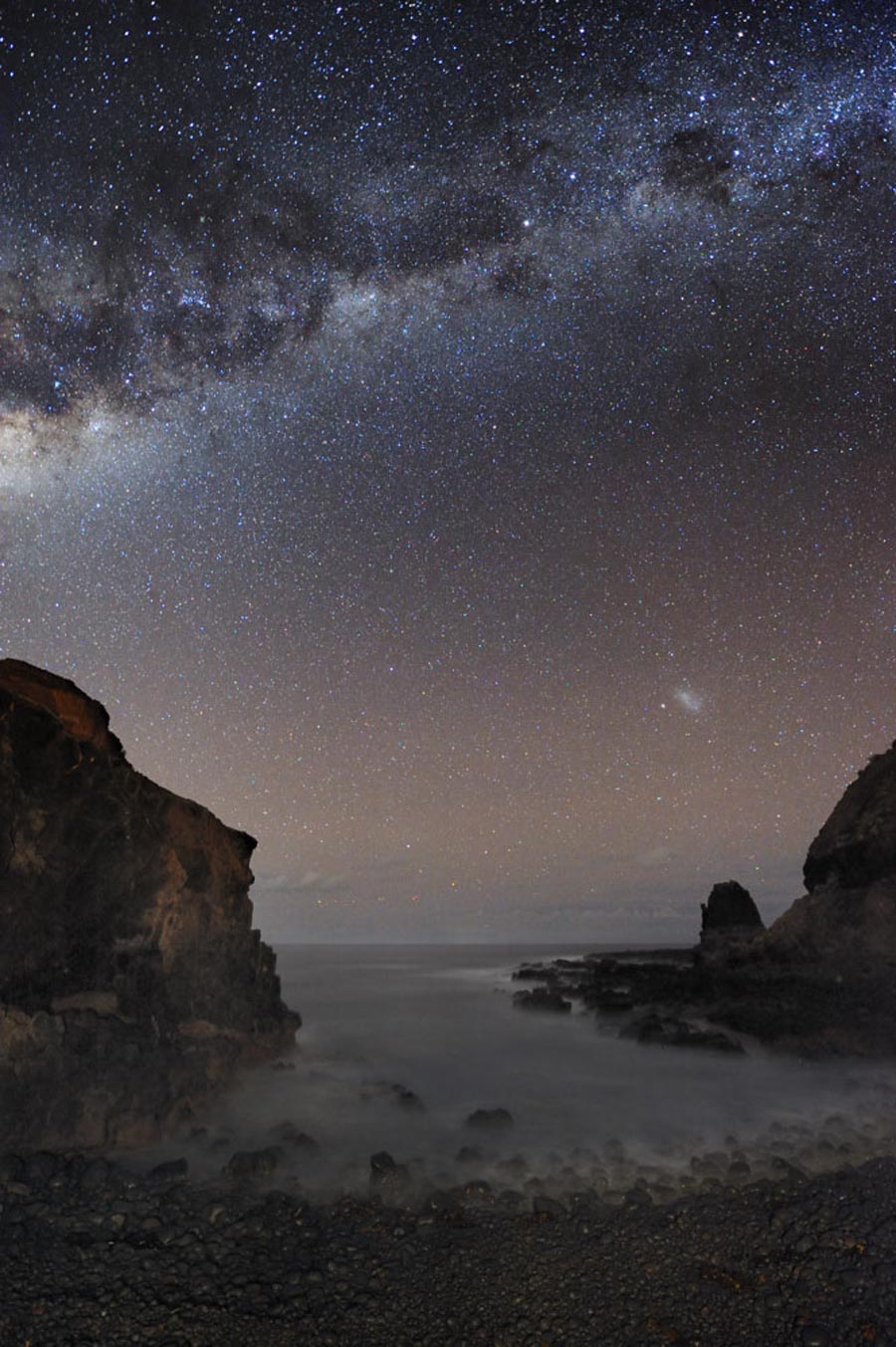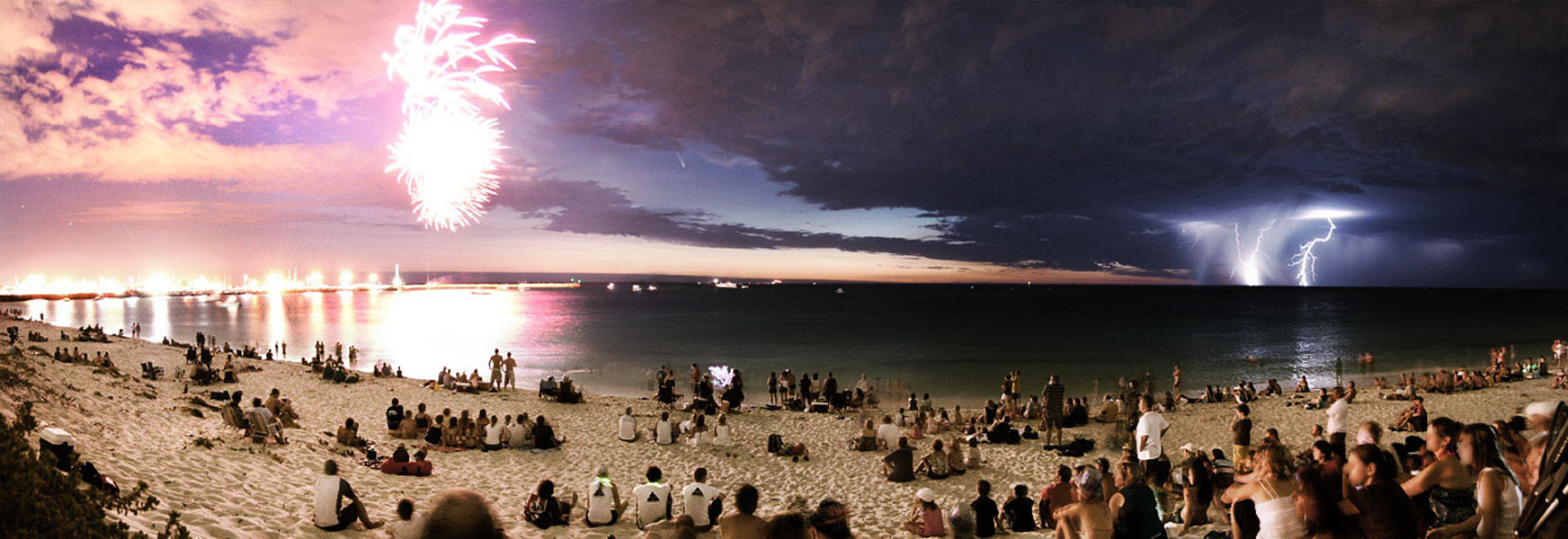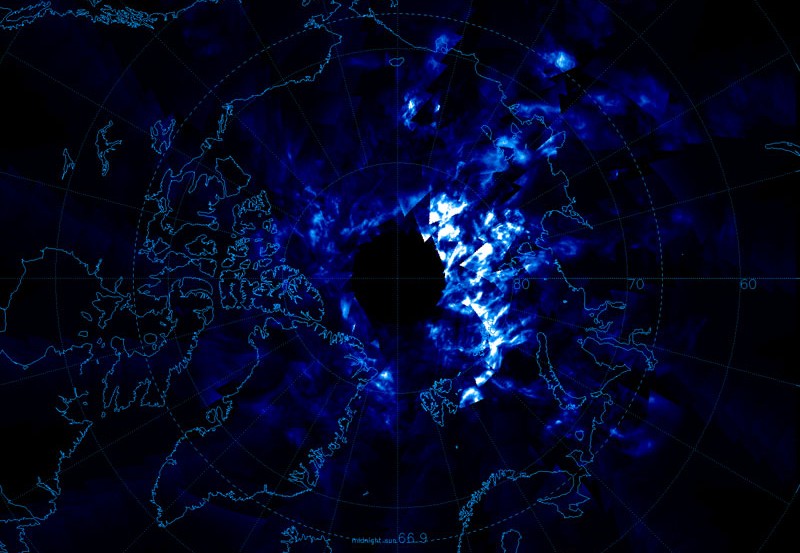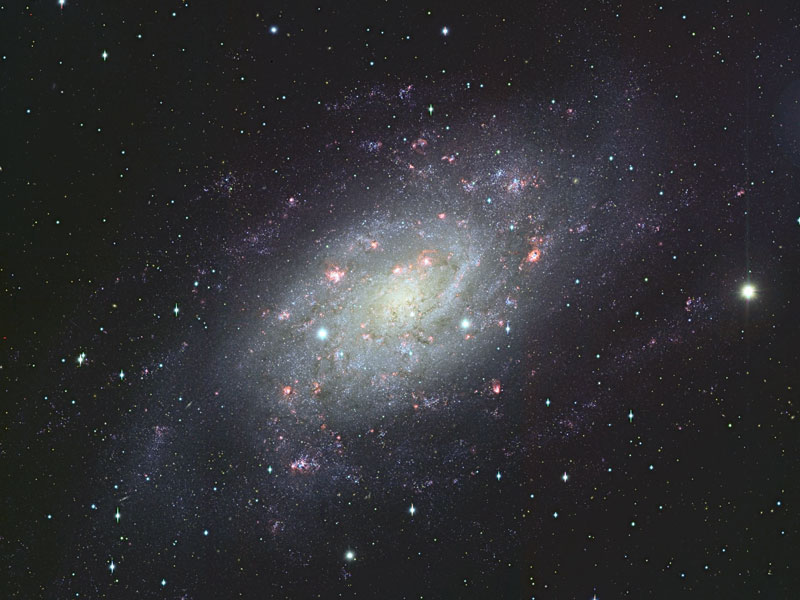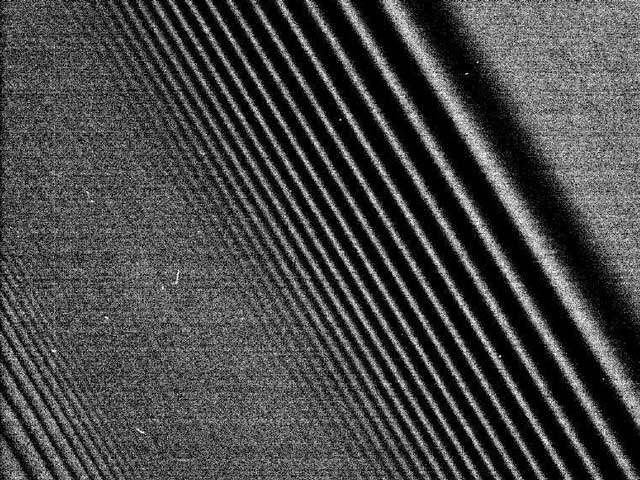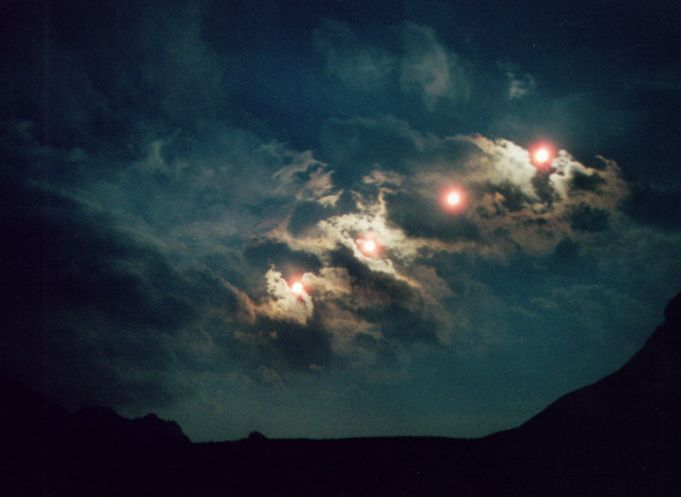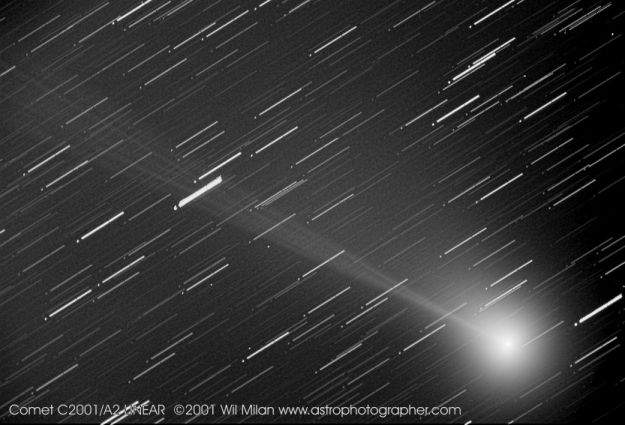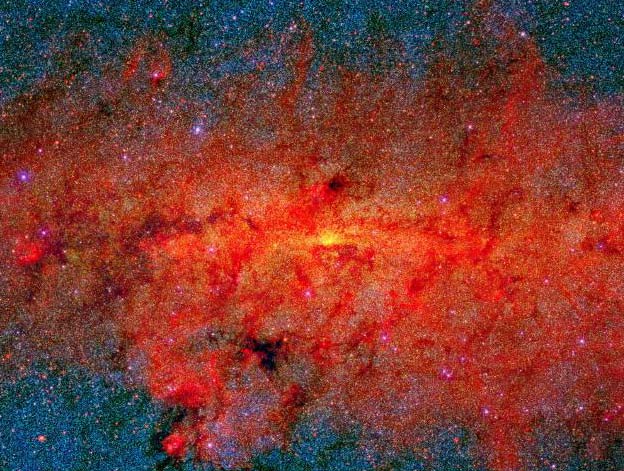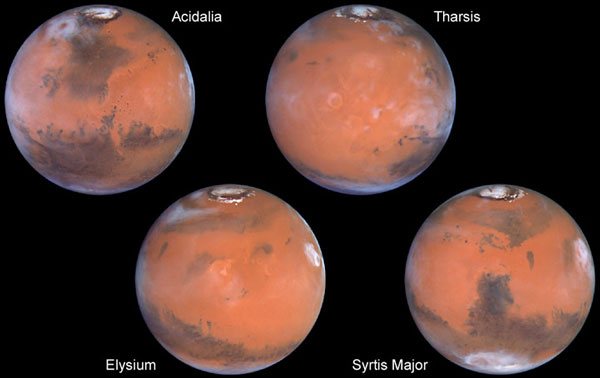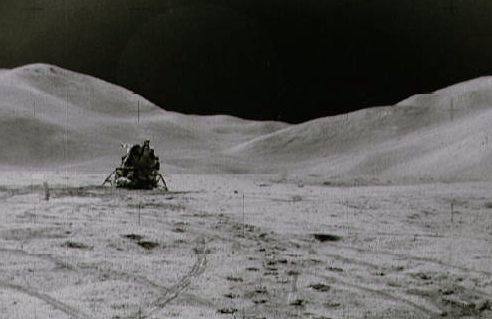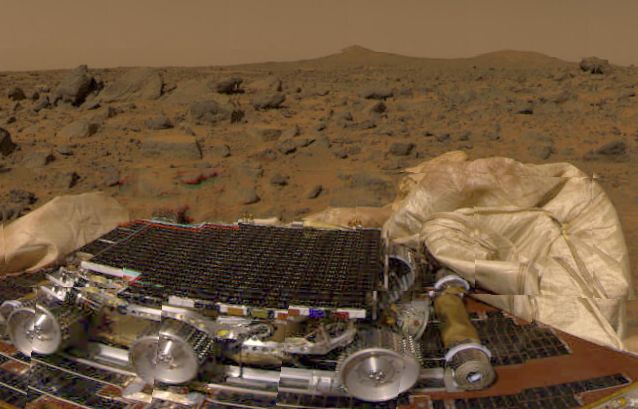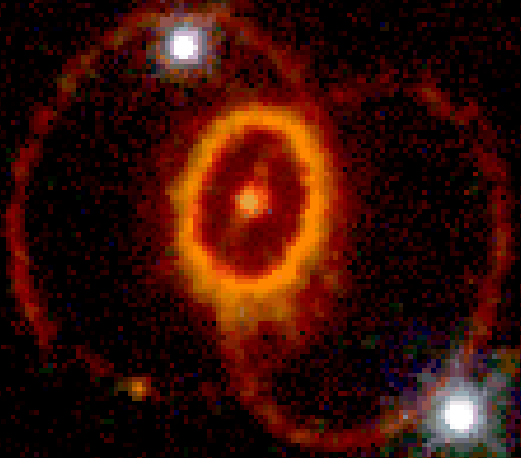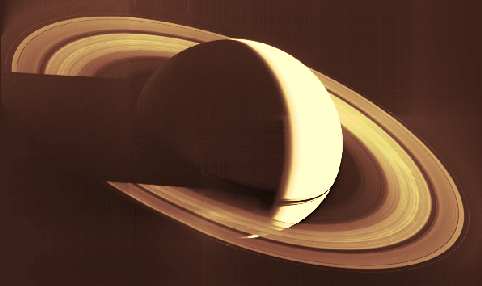| << Previous | Index | Next >> |
2015 Like a ship plowing through cosmic seas, runaway star Zeta Ophiuchi produces the arcing interstellar bow wave or bow shock seen in this stunning infrared portrait. In the false-color view, bluish Zeta Oph, a star about 20 times more massive than the Sun, lies near the center of the frame, moving toward the left at 24 kilometers per second. Its strong stellar wind precedes it, compressing and heating the dusty interstellar material and shaping the curved shock front. Around it are clouds of relatively undisturbed material. What set this star in motion? Zeta Oph was likely once a member of a binary star system, its companion star was more massive and hence shorter lived. When the companion exploded as a supernova catastrophically losing mass, Zeta Oph was flung out of the system. About 460 light-years away, Zeta Oph is 65,000 times more luminous than the Sun and would be one of the brighter stars in the sky if it weren't surrounded by obscuring dust. The image spans about 1.5 degrees or 12 light-years at the estimated distance of Zeta Ophiuchi.
2014
2013 Some 13,000 light-years away toward the southern constellation Pavo, the globular star cluster NGC 6752 roams the halo of our Milky Way galaxy. Over 10 billion years old, NGC 6752 follows clusters Omega Centauri and 47 Tucanae as the third brightest globular in planet Earth's night sky. It holds over 100 thousand stars in a sphere about 100 light-years in diameter. Telescopic explorations of the NGC 6752 have found that a remarkable fraction of the stars near the cluster's core, are multiple star systems. They also reveal the presence of blue straggle stars, stars which appear to be too young and massive to exist in a cluster whose stars are all expected to be at least twice as old as the Sun. The blue stragglers are thought to be formed by star mergers and collisions in the dense stellar environment at the cluster's core. This sharp color composite also features the cluster's ancient red giant stars in yellowish hues.
2012 Magnificent spiral galaxy NGC 4565 is viewed edge-on from planet Earth. Also known as the Needle Galaxy for its narrow profile, bright NGC 4565 is a stop on many telescopic tours of the northern sky, in the faint but well-groomed constellation Coma Berenices. This sharp, colorful image reveals the galaxy's bulging central core cut by obscuring dust lanes that lace NGC 4565's thin galactic plane. An assortment of other background galaxies is included in the pretty field of view, with neighboring galaxy NGC 4562 at the upper left. NGC 4565 itself lies about 40 million light-years distant and spans some 100,000 light-years. Easily spotted with small telescopes, sky enthusiasts consider NGC 4565 to be a prominent celestial masterpiece Messier missed.
2011 Why does the shadow of this volcano look like a triangle? The Mount Teide volcano itself does not have the strictly pyramidal shape that its geometric shadow might suggest. The triangle shadow phenomena is not unique to the Mt. Teide, though, and is commonly seen from the tops of other large mountains and volcanoes. A key reason for the strange dark shape is that the observer is looking down the long corridor of a sunset (or sunrise) shadow that extends to the horizon. Even if the huge volcano were a perfect cube and the resulting shadow were a long rectangular box, that box would appear to taper off at its top as its shadow extended far into the distance, just as parallel train tracks do. The above spectacular image shows Pico Viejo crater in the foreground, located on Tenerife in the Canary Islands of Spain. The nearly full moon is seen nearby shortly after its total lunar eclipse last month.
2010 Can a picture of the sky be relaxing? A candidate for such a picture might be this image taken only last month from Cape Schank, Victoria, Australia. The frame is highlighted by a dreamlike lagoon, two galaxies, and tens of thousands of stars. The rock cropping on the left may appear from this angle like a human head, but the more famous rock structure is on the far right and known as Pulpit Rock. Across the top of the image runs a distant stream of bright stars and dark dust that is part of the disk of our spiral Milky Way Galaxy. On the right, just above Pulpit Rock, is the Milky Way's small neighboring galaxy the Small Magellanic Cloud (SMC). The bright white object just to the left of the SMC is a globular cluster of stars in the Milky Way known as 47 Tucana.
2009 A flying saucer from outer space crash-landed in the Utah desert in 2004 after being tracked by radar and chased by helicopters. No space aliens were involved, however. The saucer, pictured above, was the Genesis sample return capsule, part of a human-made robot Genesis spaceship launched in 2001 by NASA itself to study the Sun. The unexpectedly hard landing at over 300 kilometers per hour occurred because the parachutes did not open as planned. The Genesis mission had been orbiting the Sun collecting solar wind particles that are usually deflected away by Earth's magnetic field. Despite the crash landing, many return samples remained in good enough condition to analyze and research is ongoing. So far, discoveries include new details about the composition of the Sun and the effects of the solar wind on unprotected material.
2008 Sometimes the sky itself is the best show in town. In January 2007, people from Perth, Australia gathered on a local beach to watch a sky light up with delights near and far. Nearby, fireworks exploded as part of Australia Day celebrations. On the far right, lightning from a thunderstorm flashed in the distance. Near the image center, though, seen through clouds, was the most unusual sight of all: Comet McNaught. The photogenic comet was so bright that it even remained visible though the din of Earthly flashes. Comet McNaught has now returned to the outer Solar System and is now only visible with a large telescope. The above image is actually a three photograph panorama digitally processed to reduce red reflections from the exploding firework.
2007 Alluring noctilucent or night-shining clouds lie near the edge of space, some 80 kilometers above Earth's surface. Of course, when viewed from space the clouds are more properly called polar mesospheric clouds (PMCs) -- seen here for the first time in image data from the Aeronomy of Ice in the Mesosphere (AIM) satellite. The clouds form over the poles in the corresponding summer season and are now being seen more frequently at lower latitudes. This paticular view from June 11 details the PMC structures forming over the north polar region in white and blue. (Black indicates no cloud data was available.) The AIM satellite should be able to track two complete cloud seasons over both poles to investigate possible connections between the high altitude night-shining clouds and global change in the lower atmosphere.
2006 Sprawling spiral arms dotted with bright red emission nebulas highlight this new and detailed image of nearby spiral galaxy NGC 2403. Also visible in the photogenic spiral galaxy are blue open clusters, dark dust lanes, and a bright but relatively small central nucleus. NGC 2403 is located just beyond the Local Group of Galaxies, at a relatively close 10 million light years away toward the constellation of the Giraffe (Camelopardalis). NGC 2403 has a designated Hubble type of Sc. In 2004, NGC 2403 was home to one of the brightest supernovas of modern times. The above image, the highest resolution complete image of NGC 2403 ever completed, was taken by the Japan's 8.3-meter Subaru telescope located on Mauna Kea, Hawaii, USA.
2005 Fireworks came early on July 4th when, at 1:52am EDT, the Deep Impact spacecraft's probe smashed into the surface of Comet Tempel 1's nucleus at ten kilometers per second. The well-targeted impactor probe was vaporized as it blasted out an expanding cloud of material, seen here 13 seconds after the collision. The image is part of a stunning series of frames documenting the event from the high resolution camera onboard the flyby spacecraft. Tempel 1's potato-shaped nucleus is approximately 5 kilometers across as seen from this perspective. Cameras onboard the impactor probe were also able to image the nucleus and impact site up-close ... until about 3 seconds before the impact. Of course, telescopes nearer to planet Earth followed the event, detecting a significant brightening of comet Tempel 1.
2004 What causes the patterns in Saturn's rings? The Cassini spacecraft just entering orbit around Saturn has started sending back spectacular images of Saturn's immense ring system in unprecedented detail. The physical cause for many of newly resolved ring structures is not always understood. The cause for the beautifully geometric type of ring structure shown above in Saturn's A ring, however, is hypothesized to be a spiral density wave. A small moon systematically perturbing the orbits of ring particles orbiting at slightly different distances causes such a density wave bunching. Also visible on the image right is a bending wave, a vertical wave in ring particles also caused by the gravity of a nearby moon. This close-up spans about 220 kilometers. Cassini is scheduled to take and send back images of the distant ringed Saturn and its unusual moons for the next four years.
2003 Its core hidden from optical view by a thick lane of dust, the giant elliptical galaxy Centaurus A was among the first objects observed by the orbiting Chandra X-ray Observatory. Astronomers were not disappointed, as Centaurus A's appearance in x-rays makes its classification as an active galaxy easy to appreciate. Perhaps the most striking feature of this Chandra false-color x-ray view is the jet, 30,000 light-years long. Blasting toward the upper left corner of the picture, the jet seems to arise from the galaxy's bright central x-ray source -- suspected of harboring a black hole with a million or so times the mass of the Sun. Centaurus A is also seen to be teeming with other individual x-ray sources and a pervasive, diffuse x-ray glow. Most of these individual sources are likely to be neutron stars or solar mass black holes accreting material from their less exotic binary companion stars. The diffuse high-energy glow represents gas throughout the galaxy heated to temperatures of millions of degrees C. At 11 million light-years distant in the constellation Centaurus, Centaurus A (NGC 5128) is the closest active galaxy.
2002 Whimsical and creative, this multiple exposure suggests that planet Earth's sky could be very dramatic indeed if it were graced by many moons. And in James Thurber's well-known children's story, Princess Lenore was comfortable with the idea of many moons, even if the wise men of the King's court failed to understand. But just for the Royal Astronomer and Mathematician, this picture has an explanation. On 2001 July 8, three days past full moon, astrophotographer Corrado Alesso loaded his camera with high-speed film and set it up in the province of Cuneo, Italy. With the shutter open, he recorded four separate one second long exposures on the same frame, covering the wide-angle lens for about 30 minutes between each exposure as the inconstant moon drifted through the night.
2001 Comet C/2001 A2 (LINEAR) has crossed the celestial equator and is heading north. Outward bound, this primordial piece of the solar system is still just visible to the unaided eye and can now be sighted by northern hemisphere skygazers as it moves through the constellation Pisces. This picture of the comet is a combination of 33 individual one minute exposures made on June 30 with a small telescope and digital camera situated in central Arizona, USA. The composite image brings out faint details in the comet's tail which was reported to extend for several degrees, beyond the camera's roughly 2 degree field of view. Closely spaced, the combined exposures were registered on the comet so background stars appear trailed. To produce the "punctuation" at the end of each star trail, two exposures near the end of the sequence were left out. As a result, the final dots nicely reveal the pattern of the background star field.
2000 The center of our Galaxy is obscured in visible light by dark dust that rotates with the stars in the Galactic Plane. In this century, however, sensors have been developed that can detect light more red that humans can see - light called infrared. The above picture shows what the Galactic Center looks like in three increasingly red bands of near-infrared light. The picture results from a digital combination of data recently taken by the 2MASS and MSX Galactic surveys. In near-infrared light (shown in blue) the dust is less opaque and many previously shrouded red giant stars become visible. In the mid-infrared (shown in red) the dust itself glows brightly, but allows us a view very close to our tumultuous and mysterious Galactic Center.
1999 As Mars rotates, most of its surface becomes visible. During Earth's recent pass between Mars and the Sun, the Hubble Space Telescope was able to capture the most detailed time-lapse pictures ever from the Earth. Dark and light sand and gravel create an unusual blotted appearance for the red planet. Winds cause sand-tinted features on the Martian surface to shift over time. Visible in the above pictures are the north polar cap, made of water ice and dry ice, clouds including an unusual cyclone, and huge volcanoes leftover from ancient times. The Mars Global Surveyor satellite orbiting Mars continues to scan the surface for good places to land future robot explorers.
1998 Could you ever call this place home? The lunar module shown above, named "Falcon," served as home for Apollo 15 astronauts David Scott and James Irwin during their stay on the Moon in July and August 1971. Meanwhile, astronaut Alfred Worden circled in the command module overhead. Harsh sunlight on the grey lunar surface lends the image an eerie quality, while the Lunar Apennine Mountains frame the background. Mount Hadley Delta is visible on the right. Visible in the foreground are tracks from the first Lunar Roving Vehicle, an electric car which enabled the astronauts to explore extended areas on the lunar surface. Apollo 15 confirmed that most lunar surface features were created by impacts. Rocks returned by the Apollo 15 crew included green glasses whose formation mechanism is still unclear.
1997 Yesterday, July 4th, using its own array of fireworks, a parachute, and a cocoon of airbags, the Mars Pathfinder spacecraft successfully bounced and came to rest on the surface of Mars at 10:07 AM Pacific Daylight Time. And the news is wonderful - the spacecraft appears to be in good health after having performed its complicated landing sequence superbly. Above is a mosaic of images from the martian surface transmitted shortly after Pathfinder reestablished communication with its mission operators on Earth. The solar powered, two foot long, 25 pound Mars Sojourner robot rover is visible crouched on the unfolded spacecraft. Surrounding Pathfinder are deflated airbags and a rock-strewn terrain. In the distance martian hills appear against a dusty brownish sky. The IMP camera which produced this view is also capable of stereo images and promises further spectacular pictures from Mars.
1996 What's causing those odd rings in supernova 1987a? In 1987, the brightest supernova in recent history occurred in the Large Magellanic Clouds. At the center of the picture is an object central to the remains of the violent stellar explosion. When the Hubble Space Telescope was pointed at the supernova remnant in 1994, however, curious rings were discovered. The origins of these rings still remains a mystery. Speculation into the cause of the rings includes beamed jets emanating from a dense star left over from the supernova, and a superposition of two stellar winds ionized by the supernova explosion.
1995 This image of Saturn was made in November 1980 by the Voyager 1 spacecraft as it flew past the ringed gas giant planet. From a spectacular vantage point, looking back toward the inner solar system, the robot spacecraft recorded this view of the night side of Saturn casting a sharp shadow across the bright rings. No Earth based telescope could ever take a similar picture. Since Earth is closer to the sun than Saturn, only the day side of the planet is visible from the Earth.
| << Previous | Index | Next >> |
